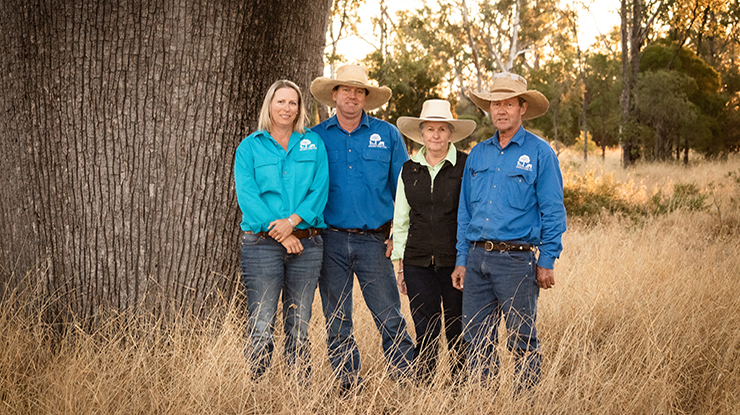 Pictured: the Gibson family
Pictured: the Gibson family
Strategic grazing, backed by data, has not only driven carrying capacity at the Central Queensland beef property, 'Coonabar' – it's also contributed to the Gibson family's fight against pasture dieback.
Murray and Wendy Gibson, their son Cameron and daughter-in-law Kristy, operate the Rolleston property, which has been in the family since 1988.
In 2007 they transitioned from a breeding enterprise to trading cattle, underpinned by time-controlled cell and rotational grazing systems which are informed by more than 22 years of grazing data.
Strategic trading has been a key to matching stocking rate to carrying capacity, as numbers can be reduced in dry periods to limit pasture deterioration and secure future feedbase reserves.
Pasture resilience
The property has flourished with the Gibsons' careful consideration of feed availability and paddock size.
Over the years, they've fenced Coonabar from two paddocks into 150 smaller ones, in recognition of the potential to improve pasture utilisation and health.
Grazing involves:
- 2,110ha under cells with cattle moving daily between 80 paddocks
- 4,381ha rotationally grazed with grazing periods adjusted depending on paddock and mob size.
"With time-controlled grazing, our paddocks are more evenly grazed – they have a large amount of manure deposited and hoof action over a 24-hour period and then given time to rest," Kristy said.
"Each paddock will be rested for an average of 360 days out of every year and never grazed down to stubble."
On a typical day, 1,000 livestock units (LSU) graze a 25ha paddock for 24 hours before being moved calmly to the neighbouring paddock.
Over the 24 years of using this approach, the Gibsons have seen their carrying capacity skyrocket from around 600 breeders in the 1980s to a maximum of 3,500 trade heifers today.
The family's commitment to maintaining 40% tree cover and high ground cover also provides shade and shelter for livestock, habitat for wildlife (a recent Birdlife Capricornia survey verifying up to 110 bird species present at the property) and reduced run-off into the Great Barrier Reef.
The Gibsons believe these strategies, which allow pastures time to rejuvenate, have been key contributors to the property's resilience against pasture dieback, which was first spotted five years ago at Coonabar.
Tackling dieback
In 2018–19, the Gibsons noticed small white insects moving on grass leaves, which they assumed were mealybugs.
In December 2020, they identified Buffel grass with yellow tips across a portion of one paddock and made the call to graze it hard, with 40 head/ha for 24 hours.
This timely decision effectively disrupted the young mealybug leaf-feeding life stages and breeding habitat for mature females, which restored the paddock back to health.
"Within three to four weeks of the mob coming out of the paddock there were beautiful dark green leaves and the yellow tinge had gone. You've got to see it to believe it. People came through and they couldn't believe the grass density and grass strength," Cameron said.
In another part of the property, Cameron saw a patch of dieback creeping up a hill. After grazing the area for four to five days the dieback subsided.
The largest patch of dieback to develop has been the size of a football field, and Cameron describes the nature of the spread as random.
"We've a lot of tree cover, sometimes it would go through tree cover and sometimes it wouldn't. It went away by itself. Look after your grass, if it's strong and healthy with good roots and resilience, it looks after itself," Cameron said.
Panic grasses and native pasture species such as Queensland Bluegrass have further contributed to pasture resilience against stressors such as the mealybug, now confirmed as the vector for pasture dieback – see story page 24. Legumes, which are resistant to mealybugs, also flourish at Coonabar.






